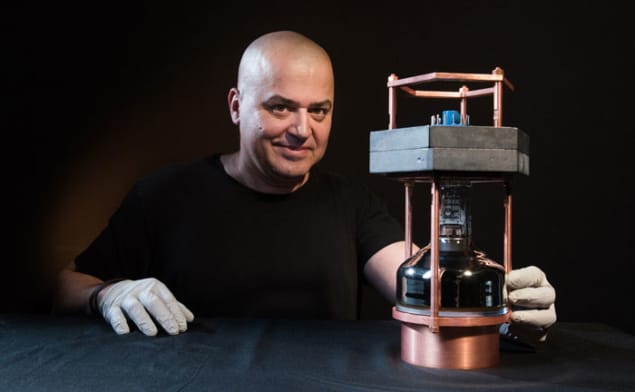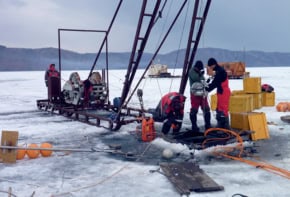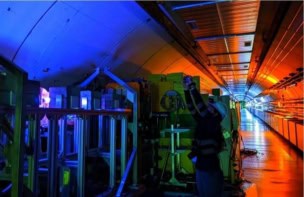
Detecting neutrinos is one of the hardest tasks in particle physics, owing to their extremely low interaction rate with particles. Huge quantities of matter are monitored just to catch a precious few events. Now, however, researchers have unveiled a new technique to catch neutrinos with much smaller detectors. It could potentially lead to extensions of the Standard Model of particle physics, and also have practical applications in nuclear non-proliferation.
Neutrinos were first detected in 1956 through inverse beta decay – an observation that would eventually win the 1995 Nobel Prize in Physics. They are detected by the weak interaction, which is mediated by the exchange of charged W and neutral Z bosons. A neutrino scattering off a proton exchanges a W boson, producing a neutron and a positron. Although this can provide valuable information, it can only detect neutrinos with fairly high energy.
Alternatively, one can detect the recoil of target particles exchanging neutral Z bosons with neutrinos. This was first achieved in 1973 at CERN’s Gargamelle detector in Geneva. The following year, theoretical physicist Daniel Freedman of the US National Accelerator Laboratory in Illinois predicted that the interaction of a low-energy neutrino could be around 100 times greater. “A particle with a long wavelength is essentially delocalized over a relatively large distance,” explains Juan Collar of the University of Chicago, “So the Z boson is effectively probing the whole nucleus and interacting with all the nucleons at the same time. To a good approximation, the probability of interaction scales with the square of the number of neutrons in the nucleus.” In principle, this so-called coherent scattering could allow a much stronger signal.
Grave difficulties
Unfortunately, a heavy, neutron-rich nucleus recoils only very slightly from the impact of a low-energy neutrino. Freedman wrote in his 1974 paper that his proposal of coherent neutrino scattering might “be an act of hubris, because the inevitable constraints of interaction rate, resolution and background pose grave experimental difficulties.” In the intervening years, however, dark matter astronomers have refined detection of low-energy nuclear recoils in detectors for hypothetical WIMPs (weakly interacting massive particles). “We have profited from all this knowledge,” says Collar.
Collar and colleagues in the COHERENT collaboration, which includes scientists in Russia, Canada, Korea and various parts of the US, performed their experiment at the most intense pulsed neutron source in the world at Tennessee’s Oak Ridge National Laboratory, where vast numbers of neutrinos are also generated. The researchers discovered a basement corridor well-screened from cosmic rays that, with the shielding (plus an extra 12 m of concrete and gravel), filtered out almost all neutrons. “Of course the neutrinos go through it like it’s not there,” says Collar. The researchers placed a target comprising just 14.6 kg of sodium-doped caesium iodide (traditional neutrino detectors require thousands of tonnes of material), and calculated the nuclear recoil from coherent neutrino scattering by measuring the increase in their signal during each pulse. Over 15 months, the researchers acquired clear evidence of coherent neutrino scattering.
Freedman, now at Stanford University, is impressed: “This process was in the background of people’s thinking,” he says. “If [the researchers] had ruled out a signal with confidence, it would have undermined not just the Standard Model but basic quantum mechanics.”
Long list of questions
The researchers have already provided new constraints to potential interactions between neutrinos and quarks that might result from some extensions to the Standard Model. Future results, says Collar, may help to answer key questions, such as whether the neutrino has an intrinsic magnetic moment and whether there are additional “sterile” neutrinos that do not interact through the Standard Model. “The list [of questions] is actually very long,” he says.
Theoretical particle physicists Joel Walker and James Dent of Sam Houston State University in Texas, who were not involved, are excited. “The neutrino sector is a very strange sector that has surprised the physics community several times already,” says Walker. Dent adds, “It would have been very surprising to people if the Standard Model signal had not been there, but that doesn’t mean it’s the only signal there. Part of our excitement is that now we can start testing this section of the Standard Model for beyond-the-standard-model physics.” Fellow theorist Patrick Huber of Virginia Tech has proposed the technique could detect “breeding blankets” placed around nuclear reactors to produce weapons-grade plutonium. “For many years, people like myself have been saying ‘Let’s assume we could detect coherent neutrino-nucleus scattering’. Now it’s happened, all these what-if scenarios become real!”
The research is published in Science.



